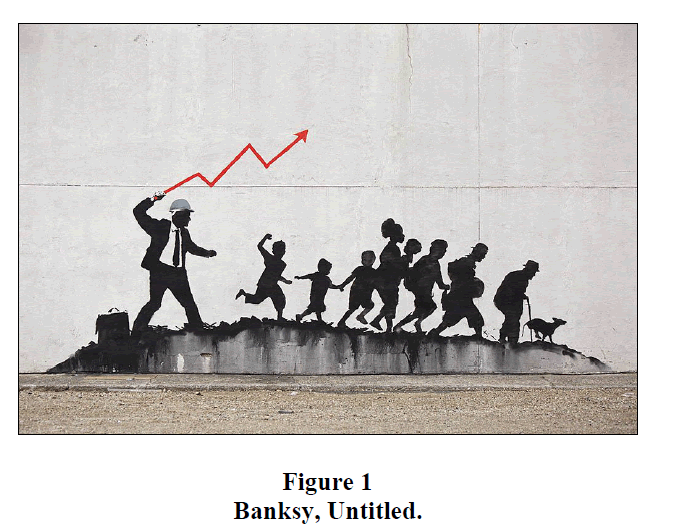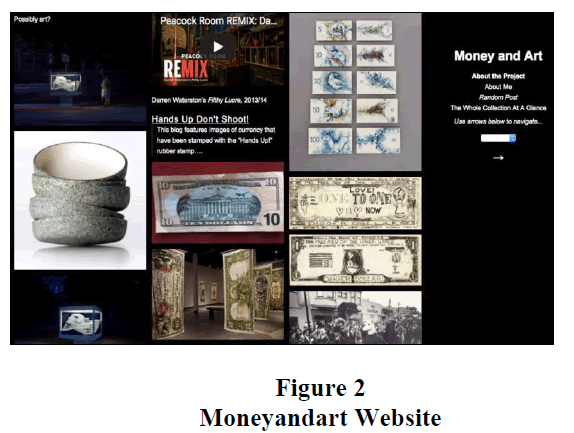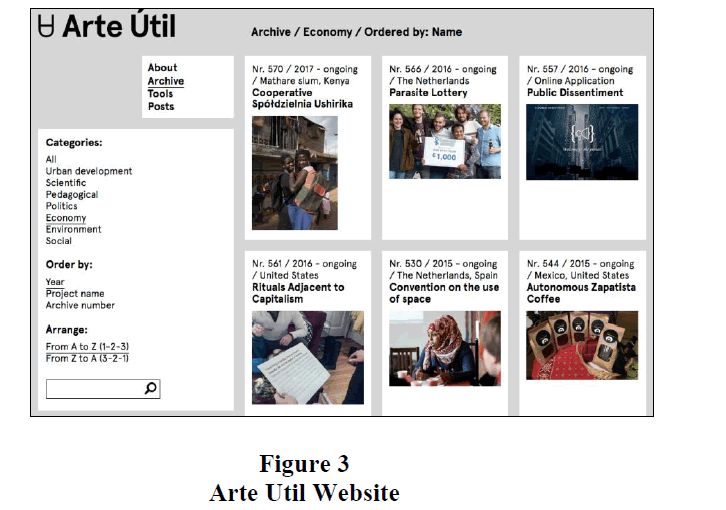Research Article: 2018 Vol: 19 Issue: 2
Contemporary Art Resources For Teaching and Learning Economics
Raúl de Arriba, University of Valencia
Abstract
Keywords
Teaching practices, Improve teaching-learning, Contemporary art, Teaching Economics.
Introduction
In recent years the efforts made to improve the quality of teaching has been focused on the introduction of methodologies that favor a more active and participatory learning of students and the intensification of the use of new technologies. In the field of teaching economics, there is also some concern about improving teaching methods through various strategies that go in the same direction. More recently, the convenience of promoting creativity as a central element in which teaching should be supported is being emphasized both from the administration and from the academic field. The development of skills that stimulate reflection, critical analysis and imagination are fundamental to improve the teaching-learning processes of the economy. Therefore, the promotion of creativity must play a central role in the transformation of teaching practices.
This requires changing practices so as not to penalize the assumption of risks and accept errors in order to stimulate creativity and innovation. To do this, we must turn creativity into an explicit learning objective and adapt evaluation systems to it. A creative attitude can only be promoted by asking students to be more creative, and if they think that this option will be rewarded. There are different ways of doing this, one of them is using contemporary art for educational purposes.
This paper analyzes the convenience and opportunities of using contemporary art multimedia resources as an educational tool for the teaching of non-artistic disciplines such as economics. The need to promote the development of skills that stimulate reflection, critical analysis, imagination, the plural interpretation of reality, the search for alternatives, etc. is essential in this area of knowledge. The analysis of this particular tool shows the opportunities offered by this approach, especially in the development of creativity.
The structure of this paper is as follows: the following section synthesizes the relationship between art and non-artistic education; next, the usefulness of multimedia resources containing contemporary art works as an educational tool in economics classes are analyzed; Finally, the text ends with the conclusions section.
Art And Education
Art is the area of development of creativity par excellence and can be a useful tool for teaching non-artistic subjects, such as economics. Its pedagogical potential has been widely studied in the field of primary and secondary education and in museums. However, in higher education, this type of experience is scarce and is a relatively recent phenomenon. There are only a few examples of creative pedagogies through poetry, haikus, literature, music or cinema; but, even less, using the visual arts (Wattsa & Christophera, 2012; Raul & Maria 2014)(Figure 1).
The reasons that support the use of art even in the teaching of non-artistic disciplines were explained by Eisner (1995). In the first place, it highlights the role of art in the development of creative thinking and its role as a mediator in the formation of concepts, especially in the social sciences (instrumental impact). In this sense, art develops an educational function for its contribution to the development of a deeper understanding and complex creative thinking. Second, by the type of contribution to experience and knowledge that only art can offer. This perspective sees art as a particular and valuable experience in the sense of Dewey (1949). From this approach, art is able to create forms that allow expressing values as visual metaphors, activates our sensibility and is able to draw attention to everyday aspects that we overlook (emotional impact, more relevant to Eisner).
The review of the literature on the subject made by Rooney (2004) points out positive affective and cognitive effects in the students who perform a learning based on art. Affective development includes greater interest in learning, self-esteem and willingness to try new things. Cognitive development refers to skills applicable to learning situations such as creativity, self-learning and complex thinking skills, such as comprehension, interpretation and problem-solving. However, the relationship between learning based on art and academic results in terms of content assimilation is not clear or, at least, is not direct or immediate. Therefore, the opportunity to use art as a pedagogical tool is justified "by itself ", that is, by its benefits in terms of developing those other capacities (Winner et al., 2013).
Multimedia Resources Of Contemporary Art On Economy
The Collections of the (Great) Museums
Almost all major museums allow access to much, if not all, of their collection through the Internet. There are many museums of contemporary art in the world. By way of illustration, below we indicate the websites of the collections of the main world centers.
Museo Nacional Centro de Arte Reina Sofia (MNCARS):
The online collection offers 8441 works of contemporary art classified into five categories: Photography, Work on paper, Painting, Sculpture and Graphic art.www.museoreinasofia.es/coleccion
Museu d'Art Contemporani de Barcelona (MACBA):
The MACBA Collection has approximately five thousand works, showing the evolution of avant-garde artistic practices from the beginning of the second half of the twentieth century. It includes works by Spanish, Catalan and international artists, particularly from South America and Eastern Europe, but also from North Africa, the Middle East and the Arab world
The web site is: www.macba.cat/es/indice-artistas
Tate Modern:
The online Tate Gallery collection includes126,721 works from 4,995 artists. It includes also the possibility of using an app.
Museum of Modern Art of New York (MoMA):
The complet collection of MoMA contains almost 200,000 works of modern and contemporary art, from around the world spanning the last 150 years. More than 77,000 works from over 25,000 artists are available online. The collection includes painting, sculpture, printmaking, drawing, photography, architecture, design, film, and media and performance art.
The web site is: www.moma.org/collection
S.M.A.K.:
The online SMAK collection offers more than 3000 works, dating from WWII, including, among others, a number of prominent movements such as Cobra, Pop Art, Minimal Art, Conceptual Art and Arte Povera.
The web site is: http://smak.be/en/collection/the-collection
Le Centre Georges Pompidou:
The Centre Pompidou collections include over 100,000 works for art of the 20th and 21st centuries. They cover the visual arts, drawing, photography, new media, experimental film, architecture, design and industrial prospects
The web site is: www.centrepompidou.fr/fr/Collections/Les-oeuvres
San Francisco Museum of Modern Art (SFMOMA):
This collection has more than 30,000 artworks. They are classified into only four categories: Painting + Sculpture; Photography; Architecture+Design; and Media Arts
The web site is: www.sfmoma.org/artists-artworks
Museum of Contemporary Art Australia (MCA)
The MCA Collection includes over 4,000 works by Australian artists, acquired since 1989. It contains all art forms as painting, photography, sculpture, works on paper and moving image, besides an important representation of works by Aboriginal artists.
The web site is: www.mca.com.au/artists-works/?primary=artists
Museum für Moderne Kunst Frankfurt/Main (MMK):
This collection contains more than 4,500 artworks by some 440 German and international artists. It includes painting, sculpture, video, photography, light, sound, and performance art.
The web site is: http://mmk-frankfurt.de/en/the-collection/the-collection
Museum of Contemporary Art, Los Angeles (MOCA):
The MOCA collection has over 7,000 art objects created after 1940, in all media.
The web site is: www.moca.org/collection/artists
Hamburger Bahnhof-Museum für Gegenwart-Berlin:
Although the collection is not online, the archive of all exhibitions since 2001 is available online.
The web site is located in the following address: www.smb.museum/en/museums-institutions/hamburger-bahnhof/exhibitions/archive
Guggenheim:
The online collection shows 1,700 artworks by more than 625 artists. This is only a small selection of the Guggenheim’s overall holdings (7,000 artworks among the Solomon R. Guggenheim Museum of New York, the Peggy Guggenheim Collection of Venice, and the Guggenheim Museum in Bilbao) from the late 19th century through today.
The web site is: www.guggenheim.org/artwork
Museu de Arte Contemporânea da Universidade de São Paulo (MAC):
Although all the collection is not online, it is possible to check through internet the archive of all exhibitions since 2008.
The web site is: www.mac.usp.br/mac/conteudo/exp/atuais/masterpager.asp
Generalist Archives In Internet
This is an encyclopedia on visual arts edited by users in Wikipedia style. It includes more than 140,000 works of art, of more than 2,600 artists, classified in about 150 movements, about 250 groups or schools, 50 genres. It does not contain only works of contemporary art, but of all times and styles.
https://artsandculture.google.com
This is the Google Art Project website that allows you to enter the collections of the world's great museums. This collection contains some 40,000 works of art, from more than 200 institutions. It allows you to search for works by different categories such as artists (more than 6,000), artistic currents (121) or techniques (231), among others. The branch Contemporary Art includes 4,690 references.
This is an independent online platform with free access to movies, podcasts, documents and videos about the avant-garde. Normally, it contains hard-to-find materials. The works are provided either by the authors or UBUweb hosts them on the site, without the permission of the artists. This platform contains works by some 7,500 artists and several thousand works of art, including some 2,500 films and videos about the avant-garde.
Video Data Bank (VDB) was created by the School of the Art Institute of Chicago (SAIC) in 1976 and is currently an essential reference in video resources on contemporary art. It includes more than 6,000 pieces of video art from more than 600 artists.
The Archive of Digital Art (ADA) documents the field of digital installation art. The archive is the result of an analysis of works located at the intersection of art, science and technology, in which artists, researchers and international institutions participate.
ADA represents a selection of 500 international artists, among approximately 5,000 artists evaluated on the basis of artistic inventions, such as interfaces, visualization or innovative software. The file allows the search by genres, which includes categories such as Digital Activism, among others.
More Specific Websites About Contemporary Art And Economy
This is a compilation of works of art of different formats elaborated by Max Haiven, a professor at Lakehead University (Canada), which investigates the links between art and economics (Haiven, 2015; 2017)1. All the pieces shown are in one way or another about money. This site is part of a research project and teaches about art and artists who use money as a means of expression or whose work connects with money and its influence. In parallel, the project explores how to understand money as an aesthetic commodity or a representative or symbolic object with tremendous power in the real world(Figure 2).
The Arte Útil project collects projects of diverse nature on its website. Arte Útil uses artistic thinking to imagine, create and implement tactics that change society in some way. As its promoter Tania Bruguera (2012) points out, "Arte Útil has to do with the understanding that art, only as a proposition, and is no longer enough. Useful art passes from the state of a proposition to that of application in the real. It has to do with understanding that the proposals that come from art have to take their next step and be applied, be an achievable utopia ".
The website contains works organized by themes such as Economy, Politics, Social Environment, Urban development, etc(Figure 3).
Art is a useful tool for the teaching of non-artistic disciplines, especially for its potential for the stimulation of creativity, among other reasons. Contemporary art, in particular, contains additional advantages given the enormous variety of formats, the creative and reflective display of many works and, of course, because it speaks of our time, including economic issues.
Currently, we can easily and freely access a huge amount of contemporary artworks that deal with economic issues, more or less directly. Apart from the online archives of the main contemporary art museums, there are more specific websites dedicated to the dissemination of the works of contemporary artists and even a project dedicated more specifically to works by artists interested in economic issues. They offer an excellent opportunity to use these unconventional resources in economics classes or other subjects connected with it.
Even so, some additional questions arise to develop in future work. The first is how to select concrete artistic techniques to encourage creativity in economics classes, where the student is a leading creator of artistic practice with formative utility, for example in areas such as image editing, video, etc. The second is how to evaluate the impact of artistic practices on the learning of the economy system and on the competencies associated with creativity. The third is how to overcome the reluctance of students when performing such unconventional practices as the use of art as an educational tool.
Endnotes
1 Indeed, money can be seen from different perspectives. In economics, the conventional approach considers money as a restriction both on individuals (Staveren, 2015) and companies (Guo and Yangxiooteng, 2017).
References
- Arriba, B.R., & Murgui, M.V. (2014). Hay espacio para el uso del arte en la enseñanza de la economía? Journal for Educators, Teachers and Trainers, 5(2), 259-271.
- Bruguera, T. (2012). Reflexiones sobre el Arte Útil. In Y. Aznar & P. Martinez (Eds.), Arte Actual: Lecturas para un espectador inquieto (pp. 194-197). Madrid: Ed. CA2M Centro de Arte Dos de Mayo.
- Dewey, J. (1949). El arte como experiencia. México: FCE.
- Eisner, E.W. (1995). Educar la visión artística. Madrid: Paidos.
- Haiven, M. (2015). Art and money: Three aesthetic strategies in an age of financialisation. Finance and Society, 1(1), 38-60.
- Haiven, M. (2018). Participatory art within, against and beyond financialization: Benign pessimism, tactical parasitics and the encrypted common. Cultural Studies, 32(4), 530-559.
- Rooney, R. (2004). Arts-Based Teaching and Learning. Review of the Literature. Washington, DC: VSA Arts.
- Staveren, I. (2015). Economics after the crisis: an introduction to economics from a pluralist and global perspective. Abingdon, Oxon: Routledge
- Wattsa, M., & Christopher, C. (2012). Using art (Paintings, Drawings, and Engravings) to teach Economics. Journal of Economic Education, 43(4), 408-422.
- Winner, E., Goldstein, T.R., & Vincent-Lancrin, S. (2013). Art for Art's Sake? The Impact of Arts Education. Paris: Educational Research and Innovation, OECD.
- Zi-Yi, G., & Yangxiaoteng, L. (2017). Credit constraint exports in countries with different degrees of contract enforcement. Business and Economic Research, 7(1), 227-241.


